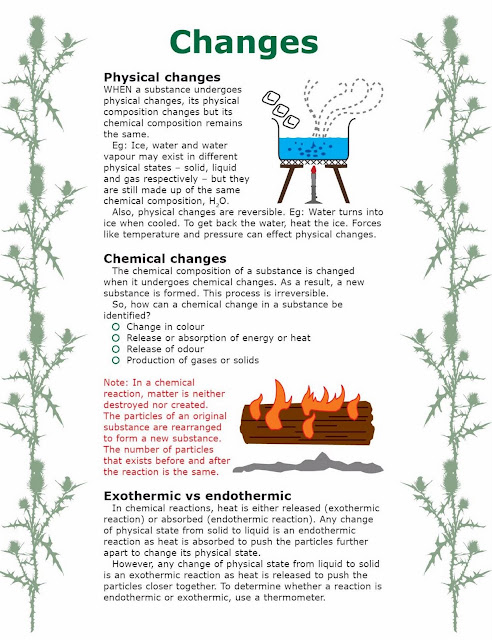Inter part 1 chemistry ThermoChemistry
Q.1 Which of the following statements is contrary to the
first law of thermodynamics?
(a) energy
can neither be created nor destroyed
(b) one
form of energy can be transferred into an equivalent amount of other kinds of
energy
(c) in
an adiabatic process, the work done is independent of its path
Q.2 The change in heat energy of a
chemical reaction at constant temperature and pressure is called
(a) enthalpy change (b) bond energy
(c) heat of sublimation (d) internal energy change
Q.3 For the reaction NaOH + HCl = NaCl + H2O, the change in
enthalpy is called as:
(a) heat of reaction (b) heat of formation
(c) heat of neutralization (d) heat of combustion
Q.4 Calorie is equivalent to
(a) 0.4184 J (b) 41.84 J
(c) 4.184 J (d) 418.4 J
Q.5 For a given process, the heat
change at pressure (qp) and constant volume (qv) are related to each other as
(a) qp = qv (b) qp < qv
(c) qp > qv (d) qp =
Q.6 The net heat change in a chemical reaction is same
whether. It is brought about in two or more different ways in one or several
steps. It is known as
(a) Henry’s law (b) Joule’s principle
(c) Hess’s law (d) Law of conservation of energy
Q.7 Enthalpy of neutralisation of
all the strong acids and strong bases has the same value because
(a) neutralisation
leads to the formation of salt and H2O
(b) strong
acid and bases are ionic substances
(c) acids
always give rise to H+ ions and bases always furnish OH– ions (d) the net
chemical change involve the combination of H+ and OH– ions to form water
Q.8 If an
endothermic reaction is allowed to take place very rapidly in the air. The
temperature of the surrounding air (a) remains constant (b) increase
Q.9 In endothermic reactions, the heat content of the
(a) products
is more than that of reactants
(b) reactants
is more than that of products
(c) both
(a) and (b)
Q.10 Hess’s law is also called
(a) first
law of thermodynamics
(b) second
law of thermodynamics
(c) first
law of thermochemistry
(d) second
law of thermochemistry
Q.11 Pressure – volume work is
(a) P v
(b) F x d
(c) h v (d) H + p v
Q.12 Kinetic energy of molecules is due to
(a) rotational energy (b) vibrational energy
(c) translational energy (d) all of these
Q.13 The condition for standard enthalpy change is
(a) 1 atm 30oC (b) 1 atm 0oC
(c) 1 atm 25oC (d) 760 atm 25oC
Q.14 The unit of enthalpy change is
(a) calorie (b) joule
(c) volt (d) coulomb
Q.15 The sum of all kinds of a system is ions or molecules
of a system is
(a) vibrational energy (b) potential energy
(c) kinetic energy (d) internal energy
Q.16 An endothermic reaction is one is which
(a) enthalpy
of reactants and products are same
(b) enthalpy
of products is greater than reactant
(c) enthalpy
of products is lesser than reactants
(d) heat
is evolved from system
Q.17 Bomb calorimeter is used to determine
(a) enthalpy
of solution
(b) enthalpy
of atomization
(c) enthalpy
of combustion
(d) enthalpy
of neutralization
Q.18 Glass calorimeter is used to determine
(a) enthalpy
of combustion
(b) enthalpy
of reaction
(c) pressure–volume
work
(d) none
of above
Q.19 Born–Haber cycle is used to calculate
(a) enthalpy
of combustion
(b) lattice
energy of ionic camps
(c) both
a and b
(d) none
of above
Q.20 Born–Haber cycle is an application of
(a) first
law of thermodynamics
(b) second
law of thermodynamics
(c) first
law of thermochemistry
(d) Hess’s
law
Q.21 An exothermic reaction is one in which
(a) enthalpy
of reactants and products are same
(b) heat
is absorbed by system
(c) enthalpy
of products is greater than reactants
(d) enthalpy
of reactants is lesser than products
Q.22 A substance under observation during an experiment
(a) surrounding (b) system
(c) state function (d) universe
Q.23 Enthalpy of neutralization is merely
(a) heat of solution (b) heat of atomization
(c) heat
of combustion
(d) heat
of formation of H2O
Q.24 Lattice energy of NaCl is
(a) + 500 kJ (b) – 344 kJ
(c) – 776 kJ (d) – 411 kJ
Q.25 Standard enthalpy of Al2O3 cannot be measured because
(a) it
does not catch fire
(b) it
reacts with CO2
(c) protective
layer of oxide cover the surface
Q.26 Ammonium chloride dissolve in water this process is
(a) endothermic process (b) exothermic process
(c) simple hydration (d) none of above
Q.27 First law of thermodynamics is represented as
(a) delta E = q + R T (b) delta E = q + delta P
(c) delta E = q + delta P (d) E = q + w
Q.28 Pumping of water uphill is
(a) spontaneous reaction (b) exothermic reaction
(c) non–spontaneous
reaction
(d) endothermic
Q.29 In exothermic reaction delta H is
(a) positive (b) negative
(c) zero (d)
none of above



No comments:
Post a Comment
Feel free to comment.Team NUST is here to listen you.